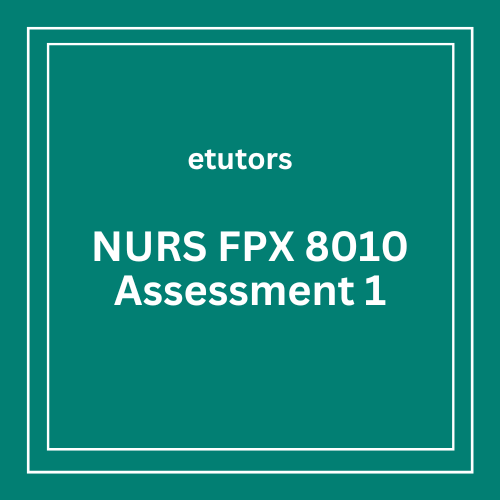Name
Capella University
NURS-FPX8010: Executive Leadership in Contemporary Nursing
Prof. Name
September 2024
Political Landscape Analysis
Political landscape analysis is a concept of the formal and informal power structures of an organization studied to understand how they tend to impact decision-making, culture, and communication (Nam & Gwang, 2024). Therefore, understanding these relationships of power is very essential in the health care system, especially in the health system, in which professional domains tend to the confluence at the leadership level, as is the case with the confluence between nursing and medicine. For instance, take a community hospital system. The physician-centric approach at a historical level proved to be very imbalanced in affecting not only policy development but also the cultural mechanisms of an organization. The actual analysis of such power dynamics will help to get noticed by the very key people to understand their influence and lay effective strategized communication and collaboration for equal strategic priorities with the necessities and requirements of all the parties.
Formal and Informal Lines of Power
In the community-based hospital system, the formal lines of power are largely represented by the executive leadership: the CEO and CMO, who have vested authority to influence policy and decision-making. This newly appointed CEO comes from a larger hospital, bringing much experience and a top-down approach to management. On the other hand, the CMO’s long time and popularity in the area give him immense informal power that he can use against opinions and garner the support of the people about ideas (Knop et al., 2024). While formal authority is merely an informal influence, it combines to give the power game in this department in the complex system that normally favors the medical departments more than others, sidelining even the nursing inputs into decisions.
The consequences of these power systems do not just impact leadership but trickle down to affect organizational culture and communication. The physician-centric model has a historical culture of fostering medicine by medicine, which has traditionally been at the expense of nursing input. Such policies may not fully reflect the concerns of the nursing staff and may be driven to a more pronounced degree in implementing the proposed transfer of APRNs to the hospitalist group. Such a scenario can create a conflict because nursing professionals feel that their work is not valued and they are also irrelevant to the strategic course of the organization. Knowledge of official and unofficial power lines, therefore, becomes an essential tool for cutting one’s way through the jungle of politics so that individual voices will not go unheard in the decision-making process.
Sources of Stakeholder Power
Power among the hospital system stakeholders is drawn from various sources, which plays a considerable role in the dynamics of the organization (North et al., 2022). The CEO draws power formally through his or her position, which creates room for strategic decisions and resource allocation. On the other hand, the CMO’s power source flows not only from his official position but also from long experience and networking with the community. That way, he can win support for projects that may be of importance to the medical department and mold the policies that are in the vision.
Nursing leaders and APRNs, though experienced and working on a crucial aspect, are unable to enforce their power with force because of the hegemony the physicians have managed to enjoy. Their authority is only partly in their favor because most of the power dynamics revolve around the interest of the medical department. Such is the case, where APRNs, in acting as nurses’ advocates and then client advocates, can together speak with a voice that can fully oppose decisions that threaten professional autonomy. Understanding and navigating sources of power would position stakeholders better to address issues or corrections at organizational policy and practice levels.
Organizational Power Influences on Executive-Level Decision-Making
Organizational power dynamics thus inform the character of the agenda of executive-level decisions due to the need to contour within harsh constraints of formal authority and informal influence (McCauley et al., 2020). The CEO’s decisions would rather be present in the form of strategic goals concerning the general overall organizational goals but highly influenced by the CMO’s perceptions and interactions with the community. In this scenario, decisions can always favor the medical department at the expense of proper nursing input indispensable for comprehensive patient care. This dependency on current power structures may avoid innovative approaches that consider the needs of all parties involved, particularly when propositions are brought before APRNs.
Assumptions
Therefore, the assumptions making the decisions in the hospital system, which are created based on beliefs of clinical leadership, which perhaps should be derived primarily by the physicians, can stem from long-standing hierarchies in healthcare settings(Guibert, 2022). Assumptions elevate the authority of the medical staff while suggesting nursing could only be a subsidiary, a basis that undermines the collaborative effort. This perspective also incorporates an assumption that providing them with financial motives, such as the implementation of a bonus system for the proposed APRNs hospitalists structure, would address all their needs surrounding roles and responsibilities. A critical analysis of these assumptions will make it easier to understand how they establish loci for the exercise of influence over policy challenge the current unbalanced approach and stimulate a balanced one, which would account for the requisite contribution of nursing professionals in the chain of patient care.
The Impact of Power on Organizational Policy
Power dynamics play a role in the trends of hospital policy, brought about by decisions made concerning the roles and responsibilities of both nursing and medical staff (Rasheed et al., 2020). All of these relate very much to physician control of decision-making processes. Physician leadership has its zeal at times, allowing policies to favor ‘medical department interests’ without considering the needs of nurses. This leads to policies that do not meet the needs or address the operational realities of APRNs and nurses involved in direct and indirect patient care, which often casts a shadow over the quality of care delivered and staff morale. With such knowledge, it becomes prudent to analyze these dynamics in order to bring in fair and collaborative policies across all disciplines.
Indeed, such a shift in APRN roles to the hospitalist group is an example of how power dictates policy that may be more beneficial or even adverse to the best interest of all parties concerned. Again, although there are financial rewards that will encourage some APRNs to work in such a model, the implications for their practice autonomy and job satisfaction are disturbing. An objective examination of these effects would reveal that policies formed within the current structures of power beget sectionalism within the workplace, hence a more inclusive power should be sought. All sections within the organization should be involved in the design and development of policies, ensuring that the actions taken would relate to the diverse needs of the healthcare team, and thereby reflect well on the desired organizational effectiveness.
Source of Power
To achieve the ultimate strategic goal of developing collaboration between the nursing and medical staff, the proper power source is found in developing professional influence and gaining expertise (Badejo et al., 2020). Using clinical expertise from nursing leaders and APRNs, the organization can come up with an effective argument for nurses in the decision-making process. This strategy empowers the nursing staff and also brings diversity in thought to enrich the depth of quality patient care. This ensures that the voices of nursing professionals are heard and valued, creating a more inclusive organizational culture.
It is also relevant to the discussion considering an ethical dimension of power. The imbalances brought about by today’s powers can cause many ethical dilemmas, mainly when making decisions that value financial incentives over professionalism and welfare. This literature evidence-based suggests the need for ethical healthcare leadership which advocates for frank and equal treatment of all the people involved. If these ethical issues are addressed by the organization and collaboration is actively promoted, then in the long run, the organization will be able to align strategic objectives set with core values that will eventually improve both staff satisfaction and patient outcomes.
Ethical Dimensions of Power
The ethical nature of power within the hospital’s system is crucial to identifying how decisions can be influential in not only the care of the staff but also the quality of care for the patients (Haahr et al., 2020). Skewed power dynamics can cultivate an environment where other professionals are marginalized or undervalued as a result of one category’s preference, such as physicians. This instills ethical implications of fairness and representation, mainly for nursing staff, which is pivotal in deciding patient outcomes. It encompasses the responsibility of creating a conducive environment where every voice is treated and considered in issues of policy-making at all times.
Ethical leadership will then also be important in navigating the relations that are in power. For leaders, transparency and accountability must then follow the avenues toward trust with the staff. Facilitating interactions characterized by healthy collaboration and respect can help reduce potential conflicts arising from organizational power imbalances; such conflicts are known to decrease workplace morale. This makes the effort congruent with the overall goal of delivering high-quality, patient-centered care; it ensures that ethical considerations are not just inherent but integral to effective leadership as well.
NURS FPX 8010 Assessment 1 Conclusion
In conclusion, the knowledge of how the system of power plays out and gets exercised in a hospital system shows the complexity of the exercise of formal and informal power against the backdrop of such system organization culture. Leadership by physicians is overemphasizing the need to have a balanced approach by giving prominence to the contributions of nursing professionals. Recognizing the ethical dimension of power and encouraging active collaboration through the exercise of such power can correct existing imbalances and get the organization into an inclusive environment. Ultimately, a focus on fair power relationships will not only make staff satisfaction better but also enable the organization to achieve the outcomes associated with good patient care organization will meet the challenges of the future by being in accordance with the core values.
NURS FPX 8010 Assessment 1 References
Badejo, O., Sagay, H., Abimbola, S., & Van Belle, S. (2020). Confronting power in low places: historical analysis of medical dominance and role-boundary negotiation between health professions in Nigeria. BMJ Global Health, 5(9), e003349. https://gh.bmj.com/content/5/9/e003349
Guibert, C., & Vázquez, M. (2022). Nurses’ clinical leadership in the hospital setting: A systematic review. Journal of Nursing Management, 30(4), 913–925. https://onlinelibrary.wiley.com/doi/10.1111/jonm.13570
Haahr, A., Norlyk, A., Martinsen, B., & Dreyer, P. (2020). Nurses experiences of ethical dilemmas: a review. Nursing Ethics, 27(1), 258–272. https://journals.sagepub.com/doi/10.1177/0969733019832941
Knop, M., Mueller, M., Kaiser, S., & Rester, C. (2024). The impact of digital technology use on nurses’ professional identity and relations of power: a literature review. Journal of Advanced Nursing. https://onlinelibrary.wiley.com/doi/10.1111/jan.16178
McCauley, L., Kirwan, M., Riklikiene, O., & Hinno, S. (2020). A scoping review: The role of the nurse manager as represented in the missed care literature. Journal of Nursing Management, 28(8), 1770–1782.https://onlinelibrary.wiley.com/doi/10.1111/jonm.13011
Nam, K. H., & Gwang S. K. (2024). The barriers and facilitators influencing nurses’ political participation or healthcare policy intervention: A Systematic review and qualitative meta‐synthesis. Journal of Nursing Management, 2024(1). https://onlinelibrary.wiley.com/doi/10.1155/2024/2606855
North, N., Brysiewicz, P., & Coetzee, M. (2022). Nursing stakeholder identification guidelines for human resources for health and health workforce development: a Scoping Review. International Nursing Review, 69(3). https://onlinelibrary.wiley.com/doi/10.1111/inr.12772
Rasheed, S. P., Younas, A., & Mehdi, F. (2020). Challenges, the extent of involvement, and the impact of nurses’ involvement in politics and policy making in last two decades: An integrative review. Journal of Nursing Scholarship, 52(4), 446–455. https://sigmapubs.onlinelibrary.wiley.com/doi/10.1111/jnu.12567







